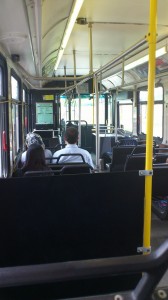By Carly McNeill
Central Winnipeg is a great area in which to live. I was fortunate enough to grow up in Norwood Flats, a quiet neighbourhood along the Red River and a mere 15 minute walk from The Forks. Transit was a big part of my life growing up. My father would take the bus to work in the North End every day. Once I reached grade seven, I, like my father, had become a dedicated transit rider. Riding the bus was fun – it was cheaper than owning a vehicle, you could ride to school with your friends, study on the way and people watch – my favourite part. I continued taking the bus all through high school and eventually to my retail job on North Main Street.
So why did I suddenly end my commitment to Transit?
 In late 2011, my job transferred me to a store at Kenaston & McGillivray. Getting to work in the morning or afternoon was never a problem from my apartment on Corydon. However, leaving work after a closing shift at ten or eleven at night was always risky. I had to race across Kenaston to catch the bus on the other side. If I missed my bus, I had to wait at least 45 minutes for another. Being alone in a deserted parking lot at night waiting for a bus can make one feel uncomfortable, and not only when it is the dead of winter. Who would hear me if someone were to attack me? Sometimes, I would skip the waiting and call a cab. My safety was worth the $25.
In late 2011, my job transferred me to a store at Kenaston & McGillivray. Getting to work in the morning or afternoon was never a problem from my apartment on Corydon. However, leaving work after a closing shift at ten or eleven at night was always risky. I had to race across Kenaston to catch the bus on the other side. If I missed my bus, I had to wait at least 45 minutes for another. Being alone in a deserted parking lot at night waiting for a bus can make one feel uncomfortable, and not only when it is the dead of winter. Who would hear me if someone were to attack me? Sometimes, I would skip the waiting and call a cab. My safety was worth the $25.
In the last couple of years I started to notice the bus was coming later and later, or early. Every bus rider knows that feeling of anticipation when your bus is not on time and you’re left staring down the street in hopes that you may see that familiar glowing orange lettering on that big white box. It came to the point where I couldn’t risk being late and I’d have to plan my commute around catching a bus one earlier than my “ideal bus”. It seems like a good idea anyway, planning two steps ahead, right? That is, unless your early bus arrives late, when your “ideal bus” was scheduled to arrive. Then, you miss your transfer bus because you didn’t plan a “back-up transfer bus,” and this one just happened to arrive ahead of schedule. This resulted in a lot of disappointment as I was forced to call a taxi from my transfer stop. Again, the $15 was worth not being late for work or an appointment. Still, when “taking transit” often includes impromptu cab rides, it adds up.
I bought a car because transit was becoming unreliable, infrequent and I felt my safety was at risk as I waited anxiously at stops alone in the dark. If there were more buses on the road, creating shorter wait times inside and more importantly, outside of rush hour, I believe ridership would increase dramatically. That being said, increased ridership is the “ying” to any of Winnipeg Transit’s future development’s “yang”. One cannot simply skip ahead and spend hundreds of millions of dollars on a project that they are attempting to disguise as the only solution to the city’s transit inefficiencies. I won’t go into detail about the “no-man’s land” location of the proposed 2nd phase of the Southwest Corridor.
Winnipeg Transit needs to focus on attracting more riders in order to make BRT an effective, useful, and valuable service. In regards to any future Rapid Transit developments, it’s all about timing (no pun intended).
Reliability and trust are key in any relationship, and that includes the relationship between a transit rider and a transit system. And that is why I broke up with Winnipeg Transit. I hope one day we can reconcile, if Winnipeg gets its transit act together.
Carly McNeill is a member of the Functional Transit Winnipeg Steering Committee..
